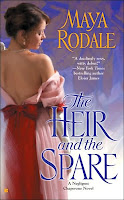 This weekend I attended the New Jersey Romance Writers conference. Also attending were Janet and Megan. Janet, my bff Julie, and I drove up 95 and the Jersey Turnpike in my Prius, which was a pleasure, not only because I have an EZPass and can zip through the tollgates, but also because Janet is a very entertaining companion and Julie is a prime navigator, my own personal JPS (instead of a GPS–get it?).
This weekend I attended the New Jersey Romance Writers conference. Also attending were Janet and Megan. Janet, my bff Julie, and I drove up 95 and the Jersey Turnpike in my Prius, which was a pleasure, not only because I have an EZPass and can zip through the tollgates, but also because Janet is a very entertaining companion and Julie is a prime navigator, my own personal JPS (instead of a GPS–get it?).
It is a bit difficult to relate New Jersey to the Regency. I do love New Jersey, though. I love the atmosphere and the people there. Unlike many southerners who say what is polite, Jersey folks are very direct and I like that! I lived there for two years in my younger days, so it always feels a little like going home.
 There were Regency authors there. Lots of them! Julia Quinn was the special presenter, giving a talk on “Dialogue: It’s More Than What You Say.” Julia’s was the best and clearest presentation about dialogue that I’ve ever heard. Eloisa James also gave a good workshop about beta heroes. But, as always, it is the informal meetings with fellow authors that I enjoy the most. I managed to spend time with Regency authors Sally MacKenzie (one of our former guests and pictured with me at the booksigning), my pal Sophia Nash, Kristina Cook, and Caroline Linden. And, of course, Janet and Megan, although I did not get to see Megan for nearly as long as I would have liked. Janet and Megan should have more photos for you.
There were Regency authors there. Lots of them! Julia Quinn was the special presenter, giving a talk on “Dialogue: It’s More Than What You Say.” Julia’s was the best and clearest presentation about dialogue that I’ve ever heard. Eloisa James also gave a good workshop about beta heroes. But, as always, it is the informal meetings with fellow authors that I enjoy the most. I managed to spend time with Regency authors Sally MacKenzie (one of our former guests and pictured with me at the booksigning), my pal Sophia Nash, Kristina Cook, and Caroline Linden. And, of course, Janet and Megan, although I did not get to see Megan for nearly as long as I would have liked. Janet and Megan should have more photos for you.
 The bookseller’s luncheon was on Sunday, and there I met an impressive young, new Regency author, Maya Rodale, whose first book, a Regency set historical, The Heir and the Spare, just came out this past August. At the luncheon, of course, Janet and I schmoozed with lovely booksellers whose enthusiasm for historical romance is heartening. So never believe it if you hear people say, “Historical is Dead.” It isn’t, and the booksellers are the ones who know!
The bookseller’s luncheon was on Sunday, and there I met an impressive young, new Regency author, Maya Rodale, whose first book, a Regency set historical, The Heir and the Spare, just came out this past August. At the luncheon, of course, Janet and I schmoozed with lovely booksellers whose enthusiasm for historical romance is heartening. So never believe it if you hear people say, “Historical is Dead.” It isn’t, and the booksellers are the ones who know!
I’m home now and back to real life. On my agenda this week are revisions of the still unnamed “Pomroy’s Story.”
What’s on your agenda this week?
Were you at the NJ conference (I saw Santa there!) and, if so, did I see you?
Were you with writer friends, at least?
Don’t forget to visit the Wet Noodle Posse blog this month if you are planning on entering the Golden Heart contest. The 2003GH finalists are sharing their tips all month–and giving away critiques!
And Happy Columbus Day





